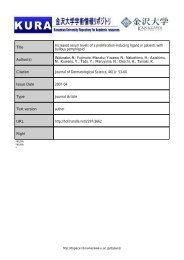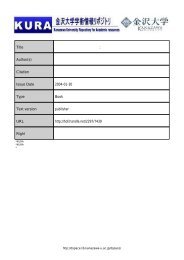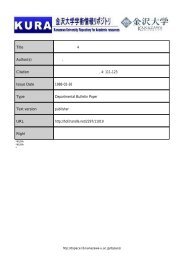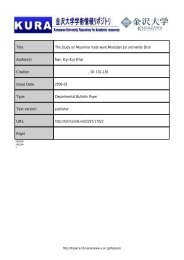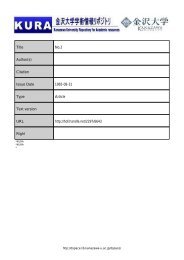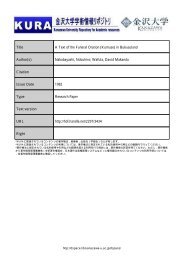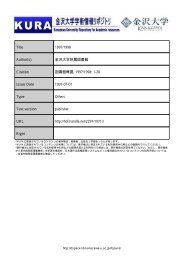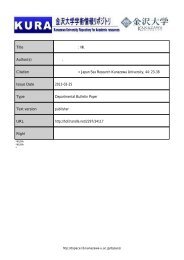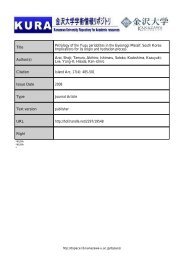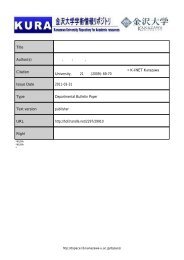Title Petrological feature of spinel lherzolite xenolith from Oki-Dogo ...
Title Petrological feature of spinel lherzolite xenolith from Oki-Dogo ...
Title Petrological feature of spinel lherzolite xenolith from Oki-Dogo ...
Create successful ePaper yourself
Turn your PDF publications into a flip-book with our unique Google optimized e-Paper software.
<strong>Oki</strong>-<strong>Dogo</strong> Island <strong>spinel</strong> <strong>lherzolite</strong> <strong>xenolith</strong> 221<br />
Fig. 2 (a) Boulder including a lot <strong>of</strong> ultramafic <strong>xenolith</strong>s at the outcrop <strong>of</strong> OKD volcanic neck. (b) Outcrop <strong>of</strong> Kuroshima alkali basalt. Arrows point to<br />
the ultramafic <strong>xenolith</strong>s. (c) Photomicrograph <strong>of</strong> <strong>spinel</strong> <strong>lherzolite</strong> <strong>xenolith</strong>s (KRB t-1). Crossed-polarized light. TJ, Triple junction. (d) Photomicrograph <strong>of</strong><br />
<strong>spinel</strong> <strong>lherzolite</strong> included in alkali basalt (KRB 4–2). Crossed-polarized light.<br />
and 1.29 ± 0.09 Ma on average, respectively (Uto<br />
et al. 1994).<br />
According to Takahashi (1978a,b), five basalt<br />
lava flows that belong to the OBG contain abundant<br />
ultramafic and mafic <strong>xenolith</strong>s including mantle-derived<br />
<strong>spinel</strong> <strong>lherzolite</strong>. These basalts contain<br />
2–15% <strong>of</strong> normative nepheline, and their SiO 2<br />
content and FeO/MgO ratio range <strong>from</strong> 45.0 to<br />
49.1 wt% and 0.60–1.15, respectively (Uto et al.<br />
1994). Takahashi (1978a) described approximately<br />
70 ultramafic and mafic <strong>xenolith</strong>s in detail and<br />
divided them into five groups on the basis <strong>of</strong> mineral<br />
assemblages and microtextures. It is noteworthy<br />
that the large amounts <strong>of</strong> angular <strong>xenolith</strong>s <strong>of</strong><br />
ultramafic and mafic rocks are densely packed<br />
(Fig. 2a) in a lava, the dyke exposed in Oku village<br />
(OKD) volcanic neck by Takahashi (1975). Kuroshima<br />
basalt is a small reef-like rock approximately<br />
100 m <strong>of</strong>f the coast intruded by OKD.<br />
Relative proportions <strong>of</strong> <strong>xenolith</strong> rock types <strong>from</strong><br />
Kuroshima alkali basalt (KRB) and OKD along<br />
with those <strong>of</strong> other localities in the South-west<br />
Japan arc are shown in Fig. 3. The KRB is the<br />
most abundant in <strong>spinel</strong> <strong>lherzolite</strong> <strong>of</strong> the five lavas<br />
(Takahashi 1978a).<br />
The five <strong>xenolith</strong>s groups classified by Takahashi<br />
(1978b) are: (1) <strong>spinel</strong> <strong>lherzolite</strong>; (2) banded<br />
<strong>spinel</strong> peridotite; (3) banded plagioclase peridotite;<br />
(4) gabbro; and (5) granulite. The banded <strong>spinel</strong><br />
and plagioclase peridotite groups contain dunite,<br />
<strong>lherzolite</strong>, wehrlite, pyroxenite and/or harzburgite.<br />
Spinel <strong>lherzolite</strong> <strong>xenolith</strong>s are up to 10 cm in<br />
diameter and most <strong>of</strong> them are approximately 7 cm<br />
(Fig. 2a). Spinel <strong>lherzolite</strong> is the major <strong>xenolith</strong><br />
type in KRB, while it is only subordinate in amount<br />
or absent in the other alkali basalt lavas in <strong>Oki</strong>-<br />
<strong>Dogo</strong>. Takahashi (1978b) considered that the<br />
banded <strong>spinel</strong> and plagioclase peridotite groups<br />
are cumulates crystallized <strong>from</strong> anhydrous basaltic<br />
magmas because <strong>of</strong> their microstructure and<br />
chemical compositions (Fe, Mn, Ti-rich; Ni, Cr,<br />
Mg-poor compared to the <strong>spinel</strong> <strong>lherzolite</strong>). They




